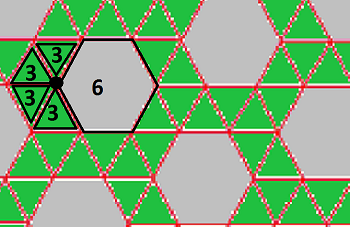

The static cache can be managed by running the Manage Feature Bin Cache tool. However, the cache is not necessarily created for all levels of detail. You cannot use a custom coordinate system.įor very large datasets or if the data is not updated often, you can enable a static cache of aggregated results. If you are unsure of the coordinate system to use, an equal area projection such as World Cylindrical Equal Area is recommended. Use the same coordinate system for the bins as the map containing the binned feature layer to avoid dynamic (on-the-fly) projection.

See Privileges for using ArcGIS with cloud data warehouses for more information.įeature binning is not supported for external tables in Google BigQuery. For Google BigQuery, which does not have table owners, the user who enables feature binning must have specific privileges granted. Only the owner of the feature class can enable feature binning.
#TESSELLATION DEFINITION ARCGIS ARCHIVE#
The data cannot be versioned or archive enabled. Feature binning in cloud data warehouses is only supported for point feature classes. The following example shows a Voronoi diagram for 6-tree sampling.Database computation for feature binning is only supported for point and multipoint feature classes stored in an enterprise geodatabase or database. The decomposition of the domain is a so called Voronoi diagram in case of k=1 and a higher order Voronoi diagram (kth order) in case that k neighbors are selected per sample point. Each polygon is composed by the infinite number of points that would lead to the selection of a particular cluster of k trees. Same like in the example above they are a decomposition of the total domain of an infinite number of possible sample point locations in exclusive areas (polygons) for each particular realization that is possible based on the given spatial distribution of trees. Also in this case it is possible to create jigsaw puzzles. In contrast to fixed area plots the neighborhood is not defined by a maximum inclusion distance (a certain fixed bandwidth) but is restricted to a fixed number of neighbors. In case of k-tree sampling single trees are selected as most nearest neighbors to a sample point. Therefore trees are buffered with the radius of sample plots. Basis for the calculation is the information about the inclusion probability of each spatially dispersed element that is derived based on the relation between a tree's inclusion zone and the total area of interest. The following description refers to a simple model that can be implemented in ArcGIS and is able to derive a tesselation for circular sample plots. This article describes, how jigsaw puzzles can be created from a map with tree locations in ArcGIS.Ī tessellation of the area of interest can e.g. The size of the polygons is an expression of the selection probability for a certain observation. This number of observations that can be obtained by sampling is the virtual population in which sampling is conducted. As the number of possible observations (derived from clusters of conjointly included trees) is much smaller than the infinite number of possible sample points, the jigsaw puzzle is a classification of the infinite sample frame in a finite number of areas of possible observations. This single tree inclusion zones are overlapping (as in most cases more than only one tree is selected by a sample point) whereas the resulting pattern is a tessellation of the total area in non-overlapping polygons, that would lead to a selection of a particular cluster of trees. Whenever a sample point falls in that distance it would lead to an inclusion of the respective tree in a sample. This "inclusion distance" can be assigned to every tree in the domain of interest. With fixed area sample plots neighbors are included up to a fixed distance (the plot radius). On the other side we can only imagine a certain discrete number of possible observations derived over a number of nearest neighbors (trees) to a certain sample point. In the infinite population approach sample elements are dimensionless points drawn from an infinite sample frame. 1993 ) is a tessellation of the total domain of interest in non-overlapping selection zones for exclusive clusters of trees. The so called jigsaw puzzle view (Roesch et al. The concept of cluster selection zones for fixed area sample plots


 0 kommentar(er)
0 kommentar(er)
